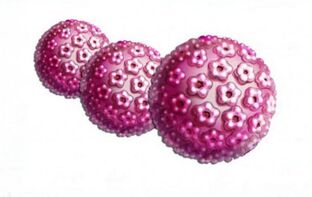
The papilloma virus can exist in the human body for a long time and does not manifest in any way. It is only activated when the immune system is weakened. In most cases, the infection does not pose a specific danger, but some strains of it, under certain factors, can degenerate into cancers. And this is a threat to human life. It is impossible to completely eliminate pathogenic microorganisms. Therefore, it is very important to know how the human papillomavirus is transmitted to reduce the risk of HPV infection.
Characteristics of a virus and how it transports
Human papillomavirus causes the formation of benign tumors on the skin and mucous membranes. They look like a papilla, protruding a few millimeters from the surface. As a rule, such growth occurs when the body's defenses are impaired. Usually a person lives quietly and doesn't even think "I can be the carrier or not". Why is the papillae formed:
- frequent hypothermia or extreme heat;
- presence of concomitant diseases;
- inappropriate nutrition;
- presence of bad habits;
- frequent stress, depression, overwork;
- lacks vitamins, minerals and other nutrients.
90% of the world's inhabitants are carriers of the papillomavirus. The immediate question arises as to whether the human papilloma virus is contagious. The answer is yes. No one is 100% insured against infection. Therefore, it is very important to know how you can get infected with HPV (Human Papillomavirus).
How human papilloma virus is transmitted
Because the likelihood of HPV infection is so high, the question often arises how to transmit the disease (human papillomavirus). Knowing the answer to this question can greatly reduce your risk of infection. Pathogenic microorganisms are transmitted from person to person. These are the most common routes of infection. Contact Infection Method:
- Sexual transmission of the HPV germ (during sex). Very often, the spread of cancer-causing microorganisms occurs this way. For example, HPV 16 and 18. Types 16 and 18 are life-threatening, as they can degenerate into cancers.
- Methods of contact infection. You can infect people by touching, hugging, or kissing. Viruses enter the body through lesions, small cracks in the skin. Therefore, you don't need to be in close contact with people if you observe the wart on their body (if you suspect it is contagious).
The transmission path could also be in water. How can you get an infection (papilloma) this way:

- through personal hygiene products (towels, face towels, toothbrushes, etc. );
- human papillomavirus can be transmitted by clothing (infection occurs through lesions of the skin);
- infections can occur in public baths, saunas (pathogens can be on floors, couches, etc. ).
The disease is not inherited. However, a newborn baby can also be infected. How can a baby develop papillomas:
- during intrauterine development from an infected mother;
- through the birth canal at the time of delivery.
Pregnant women need to take extreme care to avoid infection or activation of pathogens.After all, not only does their health depend on this, but also the baby's life.
Human papilloma (HPV), how it is transmitted: Infection can occur in medical centers, hair salons, and beauty salons due to inadequate sterilization of tools. This happens extremely rarely, because such facilities, as a rule, meet all sanitary standards, but still have room to exist.
The infected person may not even know about it. Therefore, it is recommended to periodically check in with each year. How the infection happened has now become clear. Thanks to that, you can take measures to prevent and avoid infection.
Sexual methods
Before that, we figured out how you can get benign cancer (papillomavirus). It is clear that most often, HPV is transmitted sexually (sexually). Furthermore, you can get infected through any form of sex (vaginal, oral, or anal sex).Papillomas through intimate (sexual) contact are passed through contact of mucous membranes, if they are damaged. Furthermore, the risk of infection is higher when having anal sex, as it is more traumatic.

With intimate contact, the risk of infection increases, the question is, is it possible to have sex with HPV if a sexual partner has this disease? Furthermore, during sexual intercourse, infection of the cancer-causing virus strains often occurs.
It is acceptable to have sex with HPV. But during that time, you should always use barrier contraception (condom). According to statistics, protection helps to avoid infection in men and women in 2 out of 3 cases. Without contraception, the risk of infection increases to 90%. If one of the people involved is infected, regular check-ups are required for the pathogenicity of the pathogen (a healthy partner in the presence of HPV).
However, during sexual intercourse, even when using contraceptive methods, undesirable phenomena can still occur. While having sex, growth can be injured. As a result, the wound can become infected or poisoned with blood. Additionally, damage to the tumor can cause it to degenerate into malignancy. Consequently, it turns out thathaving sex during HPV treatment is undesirable.If you do this, be extremely careful. But it's better to stay connected only after treatment. Sexual life after papillectomy is less risky.
It is believed that the papillomavirus virus can be activated by masturbation. Allegedly, this is an inadequate intercourse, thus causing a hormonal disturbance and weakening the immune system. This opinion is wrong. Masturbation does not affect the protective functions of the body.
Oral sex
HPV can be passed from woman to man and vice versa by having oral sex. This occurs through small wounds in the skin and mucous membranes. Through oral sex, the strains of HPV that are most often transmitted, can degenerate into cancer.
Condoms for oral sex only reduce the risk of infection if the blow is done. With cunnilingus in 90% of cases, infection cannot be avoided.
Can the human papillomavirus virus be spread from mother to child?
How the most common adult papillomavirus infection we have figured out. Now it is important to understand if the human papillomavirus is transmitted from mother to child, how it happens, and what is the risk to the newborn.
In a newborn, infection can occur by touching and kissing the mother if the mother carries disease-causing microorganisms. Infection enters the baby's body through damage to the skin or mucous membranes.
Infections can also occur during fetal development. From an infected woman to her unborn baby. In addition, infection can occur during childbirth. Although rare, it has dire consequences.

Through kisses and blood
How is a human papillomavirus infection spread:
- through saliva;
- through a kiss;
- through blood.
An immediate question arises, if HPV is transmitted by kissing, can you kiss an infected person? This decision is up to you. If you are 100% sure that there is no (even microscopic) lesion in the oral cavity, a kiss is completely acceptable. However, this is quite a risky decision. There may be mouth lesions that you do not feel and you may not even recognize.
The possibility of transmitting papillomavirus in humans through blood has not been scientifically proven. There have been cases of infection during blood transfusion.However, this is not proof that pathogens can be transmitted this way.Probably infection in these cases was due to poorly disinfected tools.
Household URL
In 85-90% of cases, it is possible to be infected through the household when one of the family members becomes infected. Disease-causing microorganisms at home are very often passed from parent to child. The child's immunity is still fragile so the child is more susceptible to infections. Water infection can occur as follows:
Disease-causing microorganisms at home are very often passed from parent to child. The child's immunity is still fragile so the child is more susceptible to infections. Water infection can occur as follows:
- If skin damage occurs, infection can occur by sharing bedding, towels, face towels, soap, cosmetics, and hugging;
- through saliva, you can become infected by using a dish, toothbrush, kissing someone with the virus;
- when dressing an infected person (especially underwear);
- in the home environment, can be self-contagious when shaving or pulling hair.
Infections in public places are also common ways of spreading germs. For example, in a swimming pool, steam bath or sauna. And frequent friendly handshakes and hugs.
How to avoid getting a papillomavirus
How to avoid getting HPV (human papillomavirus):
- avoids frequent partner changes;
- protects yourself when being intimate;
- does not use other people's belongings;
- does not wear other people's clothing;
- avoid public baths, saunas, swimming pools (or at least bring personal towels, interchangeable shoes);
- do not drink, drink or eat food from an infected person;
- carefully approaches a choice of cosmetology, clinics, hair salons (you need to ensure that all disinfection rules are followed in the facility);
- Do not have close contact with someone carrying the virus.
If you develop papilloma, see your doctor. Your doctor will make the necessary diagnoses, determine the strain of the bacteria that causes the disease and, if necessary, prescribe an effective treatment.
Does the condom protect
If one of the sex partners is infected with HPV, a condom should be used during sexual intercourse. However, birth control does not 100% guarantee that the disease will not be transmitted. Of course, thepathogen wouldn't be able to penetrate the condom, but infection could happen in a different way.
Infections can occur through foreplay. Through small cracks in the skin or in the mouth. In this case, a barrier contraceptive won't save.
Methods of treatment
If you are a carrier of the HPV virus, the infection may be inactive in your body and cause no problems.To prevent growth in your body, you need to monitor the state of your immune system.The healthier you get, the lower your risk of developing cancer.
If there is a papilloma, your doctor may advise you not to take any action (as long as the papilloma is not offensive and does not have a cancer-causing strain). If a decision is made to remove the tumor, then as a rule, this is done by conservative methods. If drug therapy does not result in treatment or there is a risk of papilloma degeneration into cancer, surgical intervention is indicated (if there are no contraindications).

























